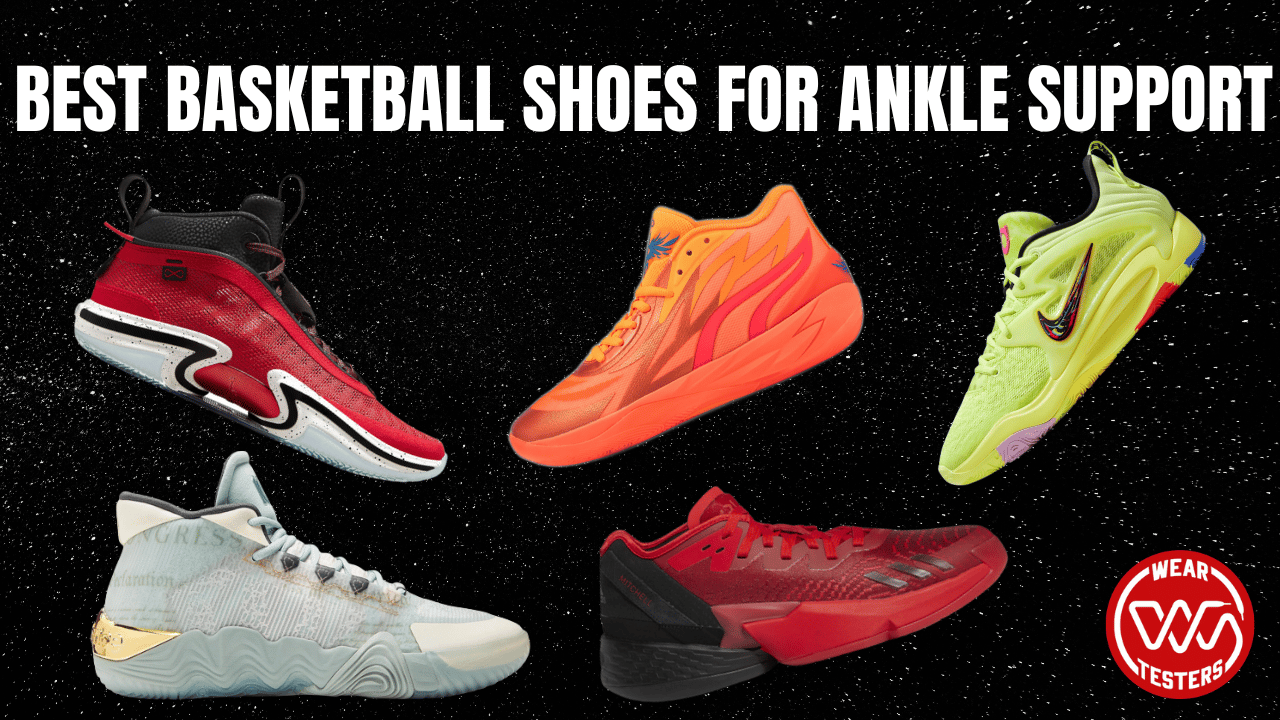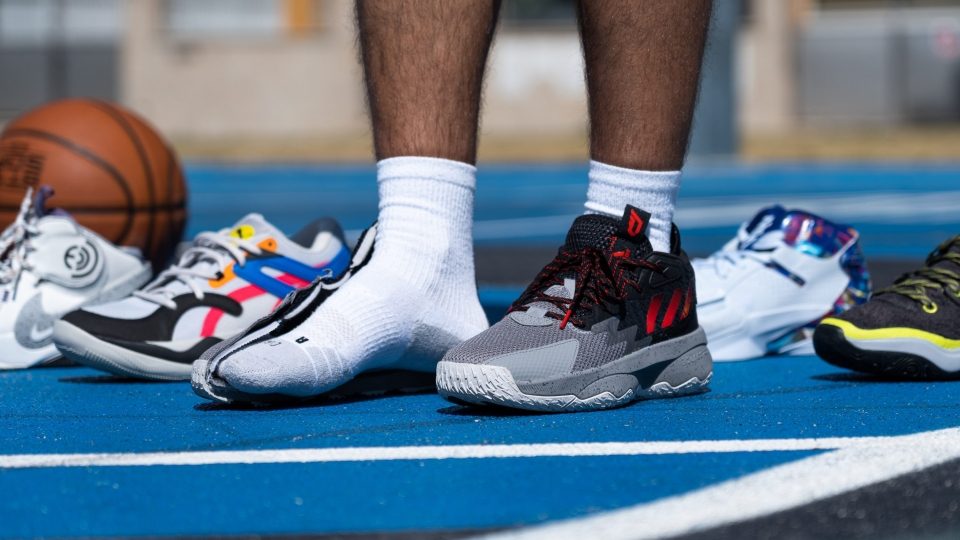Basketball shoes provide excellent ankle support due to their high-top design and cushioned construction, minimizing the risk of injuries. Many professional athletes and casual players rely on basketball shoes for added stability and protection during intense gameplay.
The specific features of basketball shoes, such as ankle collar padding and durable materials, are designed to enhance performance and prevent ankle sprains or twists. Investing in a quality pair of basketball shoes can significantly benefit your overall playing experience and help maintain your ankle health.
Whether you are a seasoned player or just starting out, choosing basketball shoes with proper ankle support is essential for maximizing your performance on the court while minimizing the chances of injury.

Credit: weartesters.com
Importance Of Ankle Support In Basketball
Basketball is an intense, high-impact sport that demands agility, speed, and quick movements. Ankle support is crucial for basketball players to prevent potential injuries and ensure stability during the game. Here, we explore the importance of ankle support in basketball and its impact on the players.
Common Ankle Injuries In Basketball
Ankle sprains, strains, and fractures are the most prevalent ankle injuries among basketball players. Twisting or rolling the ankle during abrupt movements such as cutting, pivoting, or landing can lead to these injuries. The lateral ligaments of the ankle are particularly susceptible to damage, causing pain and swelling.
Impact Of Ankle Injuries On Players
Ankle injuries can have a detrimental impact on players, hampering their performance and on-court presence. Loss of strength, explosiveness, and agility due to ankle injuries can impede a player’s ability to maneuver swiftly, jump effectively, and maintain balance. Moreover, prolonged absence from the game for recovery can disrupt the team’s dynamics and overall performance.

Credit: www.thehoopsgeek.com
Basketball Shoe Design For Ankle Support
Ankle support is crucial in basketball shoes to prevent injuries. When it comes to choosing the right basketball shoes for ankle support, understanding the design features can make a significant difference in your game performance and injury prevention.
High-top Vs. Low-top Basketball Shoes
High-top shoes offer more ankle support due to their higher collar design. Low-top shoes provide more flexibility but less ankle stability.
Features To Look For In Basketball Shoes For Ankle Support
- Padding: Opt for shoes with ample padding around the ankle collar for support.
- Lacing System: Look for shoes with a secure lacing system to keep your ankles stable.
- Heel Counter: A sturdy heel counter provides additional support to the ankle.
- Midsole Cushioning: Cushioning in the midsole can help absorb impact and reduce strain on the ankles.
- Traction: Good traction prevents slipping that can lead to ankle injuries.
Benefits Of Basketball Shoes With Ankle Support
Basketball shoes with ankle support provide numerous benefits such as preventing ankle injuries, improving stability, and enhancing overall performance on the court. The design features and materials of these shoes aim to protect and support the ankles, providing players with the confidence they need to make sharp movements and quick cuts without risking injury.
Reduced Risk Of Ankle Injuries
Basketball shoes with ankle support lower the likelihood of ankle strains during intense gameplay.
Increased Stability And Balance
Ankle-supportive basketball shoes enhance stability and balance on the court.
Improved Performance On The Court
Basketball shoes with ankle support aid in better performance due to increased ankle stability.
Debunking Myths About Basketball Shoes And Ankle Support
Debunking Myths about Basketball Shoes and Ankle Support
Myth 1: Only High-top Basketball Shoes Provide Ankle Support
There’s a common belief that only high-top basketball shoes can offer adequate ankle support, but this may not be entirely true. Ankle support in basketball shoes is determined by various factors, including the construction of the shoe, cushioning, and stability features. It’s essential to understand that the height of the shoe is just one aspect to consider when evaluating its ankle support capabilities.
Myth 2: Ankle Injuries Are Solely Dependent On Shoe Type
It’s often assumed that ankle injuries in basketball are solely dependent on the type of shoe worn. However, while the right basketball shoes can help reduce the risk of ankle injuries, other factors such as playing surface, player conditioning, and proper technique also play a crucial role in preventing ankle injuries. Basketball shoes can provide support, but a holistic approach to injury prevention is necessary to ensure overall ankle health and safety.
Tips For Choosing The Right Basketball Shoe For Ankle Support
When it comes to playing basketball, having the right footwear is crucial, especially when it comes to ankle support. Ankle injuries are common in basketball, but choosing the right basketball shoe can help prevent these injuries and provide the necessary support. Here are some tips for choosing the right basketball shoe for ankle support.
Consider Your Playing Style And Position
Your playing style and position on the court should be taken into consideration when choosing basketball shoes. Different positions require different types of movement, and certain shoes cater to specific playing styles. For example, if you are a guard who often makes quick cuts and changes direction, you may want to opt for lightweight shoes with excellent lateral support. On the other hand, if you are a post player who frequently engages in physical contact under the basket, you may prefer shoes with more ankle stability and cushioning.
Try On Different Shoes And Get Proper Fit
Trying on different basketball shoes is essential to find the perfect fit. The fit of the shoe is crucial for ankle support and overall comfort during gameplay. Shoes that are too tight can restrict movement and increase the risk of ankle injury, while shoes that are too loose may not provide enough support. When trying on shoes, make sure to wear the same type of socks you would wear during games and spend enough time moving around in the shoes to assess their comfort and fit. It is also essential to consider the width and arch support of the shoe for a proper fit.
Consult With A Podiatrist Or Sports Specialist
If you are unsure about which basketball shoe is best for your ankle support needs, it is highly recommended to consult with a podiatrist or sports specialist. These professionals can provide valuable insights and recommend specific shoe features based on your foot structure, previous injuries, and playing style. Consulting with an expert can help you make an informed decision and ensure that you choose the right shoe that provides optimal ankle support.

Credit: runrepeat.com
Frequently Asked Questions On Are Basketball Shoes Good For Ankle Support?
Are Basketball Shoes Good For Ankle Support?
Basketball shoes are designed with ankle support in mind. They offer extra stability, cushioning, and secure fitting to protect your ankles from sprains and injuries. The high-top design and advanced technology used in basketball shoes provide additional support to the ankles, making them a good choice for players who need extra protection.
Conclusion
Basketball shoes can provide significant ankle support during play. The design and features of these shoes are specifically engineered to reduce the risk of ankle injuries. Players should consider their individual needs and preferences when choosing the ideal basketball shoe for ankle support.
It’s important to prioritize both comfort and performance for a safe and effective playing experience.



